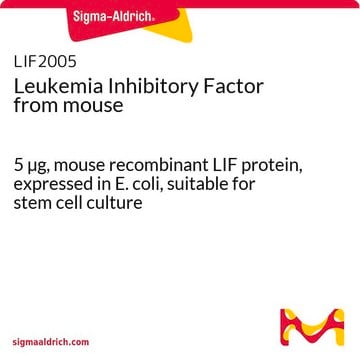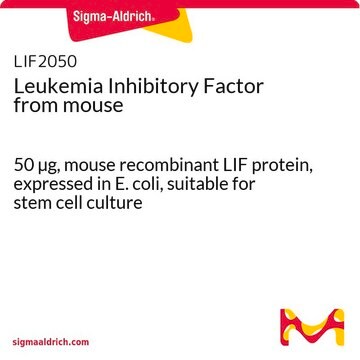LIF2010
Leukämiehemmender Faktor der Maus
10 µg, mouse recombinant LIF protein, expressed in E. coli, suitable for stem cell culture
Synonym(e):
LIF, Differentiation-stimulating Factor, D Factor
About This Item
Empfohlene Produkte
Biologische Quelle
mouse
Qualitätsniveau
Assay
>95% (HPLC and SDS-PAGE)
Form
liquid
Spezifische Aktivität
≥1 x 10(E8) U/mg
Hersteller/Markenname
Chemicon®
Konzentration
10 μg/mL
Methode(n)
cell culture | stem cell: suitable
Verunreinigungen
<0.1 ng/mg Endotoxin (of LIF)
Aufnahme
sample type neural stem cell(s)
sample type mesenchymal stem cell(s)
sample type: mouse embryonic stem cell(s)
sample type hematopoietic stem cell(s)
sample type induced pluripotent stem cell(s)
NCBI-Hinterlegungsnummer
UniProt-Hinterlegungsnummer
Versandbedingung
wet ice
Anwendung
M1 Bioassay
1. Der M1 Bioassay wird unter Verwendung von in-vitro halbfesten Agarkulturen durchgeführt, die etwa 100 Zellen in 1 ml-DME-Volumina mit 20 % FCS in 0,3 % Agar enthalten.
2. 100 μl Probe oder mLIF (10(E4) Einheiten/ml in 5 % FCS in isotonischer Kochsalzlösung) in seriellen Verdünnungen in doppelter Ausführung in 35-mm-Petrischalen geben.
3. 100 μl 5 % FCS in isotonischer Kochsalzlösung auf zwei Kontrollobjektträger geben.
4. Bei 37 °C in feuchter Atmosphäre (10 % CO2 in der Luft) 7 Tage inkubieren.
5. Die Anzahl der Kolonien zählen, die eine Differenzierung aufweisen (Hinweis: 50 Einheiten sind definiert als die Menge an Aktivität, die zu einer Differenzierung von 50 % der Kolonien führen).
Weitere Informationen sind unter www.esgro-lif.com aufgeführt
Hergestellt von CHEMICON International, Inc. LIF ist unter den US-Patentnummern 5.187.077, 5.427.925, 5.443.825, 5.750.654 und 6.261.548, der europäischen Patentnummer 0285 448 und verwandten ausländischen Patenten geschützt und nicht für den Weiterverkauf vorgesehen.
Einheitendefinition
Hinweis zur Analyse
Rechtliche Hinweise
Lagerklassenschlüssel
12 - Non Combustible Liquids
WGK
WGK 1
Flammpunkt (°F)
Not applicable
Flammpunkt (°C)
Not applicable
Analysenzertifikate (COA)
Suchen Sie nach Analysenzertifikate (COA), indem Sie die Lot-/Chargennummer des Produkts eingeben. Lot- und Chargennummern sind auf dem Produktetikett hinter den Wörtern ‘Lot’ oder ‘Batch’ (Lot oder Charge) zu finden.
Besitzen Sie dieses Produkt bereits?
In der Dokumentenbibliothek finden Sie die Dokumentation zu den Produkten, die Sie kürzlich erworben haben.
Artikel
Leukemia Inhibitory Factor (LIF) is a stem cell growth factor used for the in vitro culture of pluripotent mouse embryonic stem cells (ES cells).
Protokolle
Stem Cell protocols for cryopreservation, thawing of cryopreserved stem cells and media preparation.
Verwandter Inhalt
This article shows that a PES membrane containing Stericup Quick Release filter provides an alternative for the pluripotent expansion of embryonic stem cells.
Unser Team von Wissenschaftlern verfügt über Erfahrung in allen Forschungsbereichen einschließlich Life Science, Materialwissenschaften, chemischer Synthese, Chromatographie, Analytik und vielen mehr..
Setzen Sie sich mit dem technischen Dienst in Verbindung.








